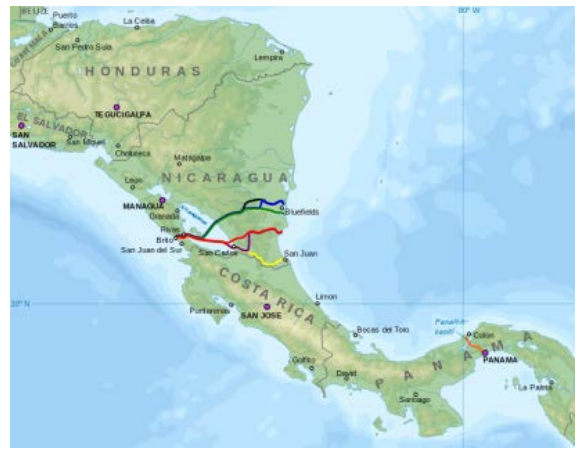Section #13 - The 1850 Compromise has Democrats backing “popular sovereignty” voting instead of a ban
Chapter 153: Talks Proceeds On A Cross-Isthmus Canal In Central America
1849 Forward
The Gold Rush Resurrects Interest In A Canal Project
While Congress is debating statehood for California, individual and corporate entrepreneurs are eager to find a fast and affordable route to reaching the riches of its gold fields.
The only existing lies in a sea voyage from the East coast around the tip of South America at Cape Horn to San Francisco which requires 25-30 days and a $400 fare for most adventurers.
A potential short-cut lies in connecting the Atlantic and Pacific oceans by constructing a continuous waterway across either Nicaragua or Panama. In both locations the oceans are separated by land masses that extend only 50-150 miles, with rivers and lakes facilitating linkage, where canals are constructed.
Such an undertaking is first explored in 1825 by commercial and military interests. At that time, surveyors map out a potential route for a canal in Nicaragua, but it is subsequently set aside given the costs and complexities.
Then the 1849 California gold rush resurrects corporate interest.

April 19, 1850
The Clayton-Bulwer Smooths The Path To A Possible Canal
Despite the “hands-off the hemisphere” warning in the 1823 Monroe Doctrine, Britain continues to lay claim to sizable territories on the east coast of both Honduras and Nicaragua, along with the west coast port of San Juan del Sur.
As talk of a possible cross-Isthmus canal heats up, negotiations are underway to make sure that conflicts over territorial interests are avoided.
Taylor’s Secretary of State, John Clayton, meets with the British diplomat Sir Henry Bulwer, and the two agree on a treaty bearing their names. It states that:
Neither country will seek territorial dominion over Nicaragua or any other country in Central America; and any canal or other path across the isthmus will be open for equal use by both nations.
The Clayton-Bulwer Treaty is ratified by a 42-11 vote in the Senate on April 19, 1850. As such it becomes the one foreign policy achievement during Zachary Taylor’s presidency.
(Note: plans for a Nicaragua Canal to rival the 1914 Panama Canal continue to the present day.)